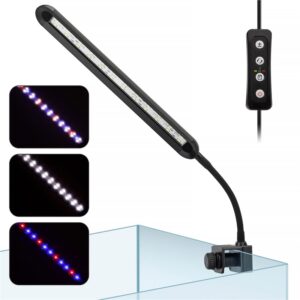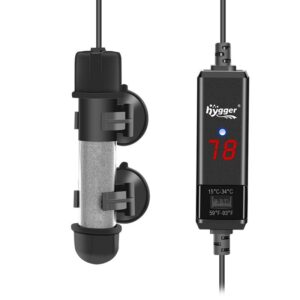Are you still distraught about the algae eater for your fish tank? Come on. Here is an effective remedy – introducing aquarium snails to your tank. Most snails are hardy and easy to care for. Nerite snails, one of the great algae eaters, are aquarists’ favorite choice. In this article, let’s take a look at nerite snails.
Content Table
Nerite snails
Brief introduction of nerite snails
As excellent algae eaters, nerite snails do not eat live aquatic plants but will eat decaying or dead ones. They are also great aquarium cleaners, which can be kept in freshwater and saltwater tanks. However, sometimes they would get out of your fish tank. Besides, nerite snails are difficult to breed and can not reproduce in freshwater aquariums. Next, we will cover some basic information about nerite snails.
- Family: Neritidae
- Scientific name: Neritina natalensis
- Size: 1 inch in diameter
- Diet: Omnivores
- Lifespan:1-2 years
- Temperament: Peaceful
- Minimum tank size: 5 gallon

Types of nerite snails
Also, there are diverse types of nerite snails, featuring different colors and patterns. And we will list some popular nerite snails here:
- Zebra nerite snails
- Horned nerite snails
- Tiger nerite snails
- Red racer nerite snails
- Black racer nerite snails
- Olive nerite snails

Tips for keeping nerite snails
Additionally, how can nerite snails survive in your fish tank? Here are some tips for keeping nerite snails.
Water parameters requirement
| Freshwater tank | Saltwater tank | |
| water temperature | 71-79℉ | 72-78℉ |
| pH level | 8.0-8.4 | 8.1-8.4 |
| Water hardness | 5-15 dKH | 8-12 dKH |
| Ammonia level | 0 ppm | 0 ppm |
| Nitrite level | 0 ppm | 0 ppm |
| Nitrate level | less than 30 ppm | less than 20 ppm |
| Calcium | – | 350-450 ppm |
| Magnesium | – | 1250-1350 ppm |
Tank decoration
What is the tank decoration requirement of nerite snails? Hard substrates may hurt your nerite snails. Hence, soft substrates are a better alternative, like sand or mud. Moreover, nerite snails need hiding places. Thus, you can add some rocks, stones, driftwood, or aquatic plants. Also, the algae will grow on these objects’ surfaces.
Aquarium supplies requirement
Considering nerite snails would get out from the tank without a lid, you’d better add an aquarium lid to your tank. Additionally, bad water quality, like high ammonia, nitrite, or nitrate levels, would be damaging to nerite snails. As a result, an aquarium filter is necessary. It can regulate water quality and maintain ideal living conditions. A small filter aquarium is a great choice. Available for mechanical and biological filtration, the small internal filter is ideal for 0.5-20 gallon aquariums.
On the other side, if cold, it is best to add an aquarium heater to keep the ideal water temperature. For instance, an aquarium mini portable heater is an excellent alternative. With an LED digital display, the heater fits 1-26 gallon tanks. Also, the 2mm thickened quartz glass protects your snails from punching.
What do nerite snails eat?
Nerite snails are omnivores. Algae are the main food sources, such as green spot algae, green algae, and brown algae. As an algae eater, how do nerite snails eat algae? With sensory tentacles and radula, nerite snails scrape off the algae on surfaces. Aside from algae, nerite snails also eat rotted or dead leaves and plants and uneaten fish food. You do not need to feed them most of the time. Nonetheless, you should add some food when there are no adequate algae.
Vegetables and meat are feasible food for nerite snails. A various and balanced diet is beneficial for nerite snails’ growth. But you should avoid overfeeding or underfeeding. It is not good for your nerite snails. Usually, you can feed the nerite snails twice a day, if necessary. But you should ensure that they can finish eating within 2–3 minutes.
In short, the following foods are available for nerite snails.
- Algae: brown algae/brown diatoms/green algae/green spot algae/green dust algae/filamentous algae/black beard algae
- Decaying or dead leaves and plants
- Fish feces
- Uneaten fish food
- Vegetables: zucchini/cucumber/squash/broccoli/carrots
- Fruits: watermelon/apple
- Blood worms/brine shrimp
- Pellets: shrimp pellets/snail pellets
- Algae wafers

How many Nerite snails per gallon
Though nerite snails are in small size, they produce a lot of waste. And you should not overstock. Otherwise, your tank may face bad conditions. Then, how many nerite snails should be kept in a fish tank? It depends on the aquarium’s state and capacity. On the one hand, if your tank has fewer algae for the algae eater, you’d better keep fewer nerite snails. Otherwise, the algae can not meet snails’ demands, then they would starve to death. Or it would help if you fed them. On the other hand, generally, you can hold one nerite snail per 5 gallons of water. Overstock would cause stress to your snails, or even lead to death.
Next, we will share some examples in the table below.
| Aquarium types & capacity | Ideal nerite snails count |
| nerite snails aquarium (below 10 gallons) | 1-3 |
| 10 gallons betta fish tank | 1-2 |
| 55 gallons freshwater fish tank | 6-8 |
| 20 gallons saltwater fish tank | 2-3 |
Reminder
Most nerite snails are easy to care for, however, baby nerite snails also need your attention. Seeing that the baby nerite snails are too small, which may be sucked into aquarium filters. Consequently, a sponge filter may be a better option. Besides that, nerite snails fancy slightly alkaline water. Therefore, it is best to make sure a pH level of 7-8.5. Otherwise, acid water would dissolve their shells.
If you are curious about other aquarium snails or more info about snails, you can go to Cleaner Snail Profile – Types of Aquarium Snails. Finally, thanks for your reading.
Related videos: Create A Snail Small Aquascape with Hygger 033 Light




Leave a comment